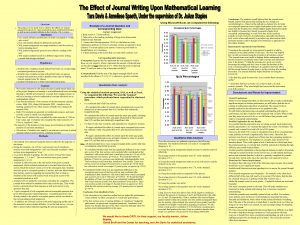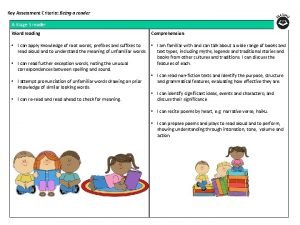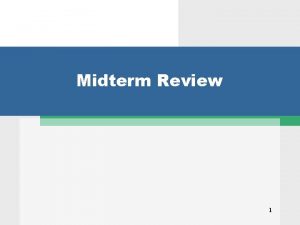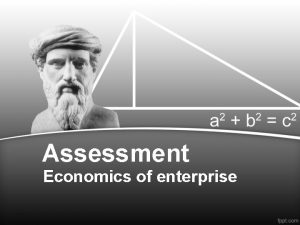Final Assessment Criteria Final 30 Midterm 30 Quizzes

















































- Slides: 49

Final Assessment Criteria: Final 30% Midterm 30% Quizzes 20% Assignments 10% Attendance 5% Presentation 5%

The U. S in the Global Economy Mc Connell and Brue Chapter 5

Chapter Objectives • Comparative Advantage, Specialization, and International Trade • How Exchange Rates are Determined in Currency Markets • How and Why Government Sometimes Interferes with Free International Trade • Role Played by Free-Trade Zones and the WTO in Promoting International Trade

International Linkages Trade Flows Goods & Services United States Economy Resource Flows Capital & Labor Information & Technology Flows Information & Technology Financial Flows Money Other National Economies

International Linkages • Trade Flows • Capital and Labour Flows: U. S firms establish production facilities abroad and foreign firms in U. S • Information and Technology Flows: Transmits information to other nations about U. S products, prices etc • Financial Flows: Imports, buying assets, aid, interest

United States and World Trade Volume and Pattern Exports of Goods & Services – 2005 Selected Countries as a Percent of GDP Belgium 87% 71% Netherlands South Korea 44% Germany 40% Canada 38% New Zealand 28% Italy 27% France 26% United Kingdom 25% Spain 13% Japan 11% United States Source: IMF, International Financial Statistics, 2005

The U. S and World Trade • Volume of international trade has been increasing both absolutely and relative to GDPs of countries • U. S now accounts for a smaller percentage of total world trade • World trade for other countries has increased more rapidly • Still leads volume wise

United States and World Trade Volume and Pattern U. S. Trade as a Percentage of GDP Inflation Adjusted to Dollar Value in 2000 Percentage of GDP Imports Exports Source: Bureau of Economic Analysis

Trade Pattern • Trade deficit : Imports exceed exports (goods) • Trade surplus: Exports exceed imports (services) • Same category goods can be both imported and exported at the same time

United States and World Trade Volume and Pattern Principal U. S. Exports & Imports – 2005 in Billions of Dollars Exports Chemicals Consumer Durables Agricultural Products Semiconductors Computers Generating Equipment Automobiles Aircraft Medical Telecommunications Imports $68. 6 53. 5 52. 9 47. 2 45. 5 33. 2 30. 4 29. 1 27. 6 25. 6 $251. 6 Petroleum 123. 7 Automobiles 97. 1 Household Appliances 93. 3 Computers Metals 83. 8 Clothing 79. 1 Consumer Electronics 47. 3 Generating Equipment 43. 1 Semiconductors 37. 1 25. 8 Telecommunications Source: Department of Commerce Data

United States and World Trade Volume and Pattern U. S. Exports & Imports – 2005 in Goods by Area Exports to Industrial Countries Developing Countries Total Value Billions Of Dollars $483 410 $893 Imports from Industrial Countries Developing Countries Total Value Billions Of Dollars $770 904 $1, 674 Source: Survey of Current Business, April 2006

Financial Linkages • How are deficits funded? -Borrowing from foreigners -Selling assets to foreigners

Rapid Trade Growth • Transportation Technology -High transport costs are a barrier to trade -Advancement and Improvements -Oil in massive tankers -Gas exported through pipelines

Rapid Trade Growth • Communication Technology -Computers, internet, fax -Link Traders and access overseas markets -Money movement -Information (e. g. exchange rates)

Rapid Trade Growth • Decline in Tariffs: -Excise taxes or duties on imported goods -Fallen since 1940 -Increased International Trade

United States and World Trade Participants in International Trade Comparative Exports - 2004 0 100 Germany United States China Japan France Netherlands Italy United Kingdom Canada Belgium South Korea Mexico Russia Taiwan Singapore 200 300 400 500 $358 $349 $347 $317 $307 $254 $189 $184 $183 $180 600 $449 700 800 $593 $566 900 $912 $819 Billions of Dollars Source: World Trade Organization

Specialization and Comparative Advantage • Open economy leads to more production of certain goods (exports) and less of others (imports) • Do such resource shifts make economic sense? • Increase productivity of a nations resources and allow for greater output and income • Ricardo: specialize even if some other economy is more productive in all economic activities

Absolute Advantage • Simpifying Assumptions: a)Constant cost (no economies or diseconomies of scale) b)Two countries two product case c)Each country must give up a constant amount of one product to secure an increment in the other d)Equal labour force

Absolute Advantage Mexico Product A B C D E Avocados 0 20 24 40 60 Soyabeans 15 10 9 5 0 U. S Product A B C D E Avocados 0 30 33 60 90 Soyabeans 30 20 19 10 0

Absolute Advantage • Output per worker in U. S exceeds that in Mexico • U. S has an absolute advantage relative to Mexico in producing both goods • Gains from specialization? Possible if the comparative cost of producing the two goods within the nations differ

Comparative Advantage To obtain 5 tons of soyabeans, 20 tons of avocados must be given up. This implies that it costs 1 ton of soyabeans to produce 4 tons of avocados. 1 S=4 A Or 1 A=1/4 S Mexico Product A B C D E Avocados 0 20 24 40 60 Soyabeans 15 10 9 5 0

Comparative Advantage It costs 10 tons of soyabeans to produce 30 tons of avocados. In other words 1 ton of soyabeans must be given up to produce 3 tons of avocados 1 S=3 A Or 1 A=3 S U. S Product A B C D E Avocados 0 30 33 60 90 Soyabeans 30 20 19 10 0

Comparative Advantage • U. S has comparative advantage over Mexico in Soyabeans (1 S=3 A vs 1 S=4 A) • Mexico has comparative advantage over U. S in Avocados (1 A=1/4 S vs 1 A=1/3 S) • So a country has said to have a comparative advantage in a product when it can produce that product at a lower domestic opportunity cost than a potential trading partner

Comparative Advantage • So if both countries specialize in the product in which they have a comparative advantage: -Both countries will achieve a larger total output with the same inputs -Better and efficient use of scarce resources

Terms of Trade • U. S can shift production between soyabeans and avocados at rate of 1 S for 3 A • Trade beneficial to U. S only if it could obtain more than 3 A for 1 S • For Mexico trade beneficial if it could get 1 S for less than 4 A • 1 S for 3. 5 A

Gains from Trade Country before after Amount traded Outputs available after trade Gains from trade Mexico 24 A 9 S 60 A 0 S -35 A +10 S 25 A 10 S 1 A 1 S U. S 33 A 19 S 0 A 30 S +35 A -10 S 35 A 20 S 2 A 1 S Improved Resource Allocation Same total inputs produce more output Problem of production constraints are over come No shift in PPF of either country

Foreign Exchange Market • Seller set prices in terms of their domestic currencies • Foreign Exchange Market: Market where various national currencies are exchanged for one another • Equilibrium prices in such countries are called Exchange rates • Enable consumers in one country to translate prices of goods into units of their own currency

Example • U. S dollar-yen rate is $0. 1 per Yen • Television costing 20, 000 Yen will cost? • If exchange rate rises to $0. 2?

The Foreign Exchange Market Exchange Rates Dollar – Yen Market P Sy Dollar price of 1 yen Exchange Rate: $. 01=¥ 1. 01 Dy Qe Quantity of yen Q

Depreciation • Anything that changes demand for yen will increase its dollar price -Incomes rising in U. S: more demand for imports -Change in peoples taste • When dollar price of yen increase we say a depreciation of dollar has occurred relative to yen • Depreciated Dollar buys fewer yens, fewer imports and more exports for U. S

Appreciation • If Japense demanded more U. S goods: Supply of Yen will increase • Dollar price for Yen will decline • Decrease in Dollar price of Yen is called the appreciation of the dollar in terms of Yen • Fewer dollars to buy Yen • U. S imports of Japanese goods rise , exports fall

The Foreign Exchange Market Exchange Rates Changing Rates: Depreciation and Appreciation Dollar Price of Foreign Currency Rises Equals Foreign Currency Price Of Dollar Falls International Value of Dollar Falls (Dollar Depreciates) Equals International Value of Foreign Currency Rises (Foreign Currency Appreciates)

Government and Trade • What kinds of trade barriers can governments erect and why?

Trade Impediments and Subsidies -Protective tariffs are excise taxes or duties placed on imported goods -Shield domestic production from foreign competition -Impede trade by raising price of imported goods

Trade Impediments and Subsidies • Import Quotas are limits on quantities or total value of specific items that may be imported -Impede trade more than tariffs • Nontariff barriers -Licensing requirements -Unreasonable standards pertaining to product quality

Trade Impediments and Subsidies • Export Subsidies are government payments to domestic producers of exported goods -Reduced costs, high production -Airbus subsidized to compete with Boeing -Agricultural Products

Why does the Government Intervene? • Misunderstanding Gains from trade -Myth: Greatest benefit is greater domestic employment in export sector -True benefit: Overall increase in output through specialization -Gains from trade : Extra output obtained from abroad for less cost than the cost to produce at home

Why does the Government Intervene? • Political Considerations -Trade harms particular domestic industries and groups of resource suppliers -Persuade government to give protection -Pursue political activity -Cost person is very small

Costs to society • Hurt consumers • Hurt producers who import inputs • Less competition: less incentive for cost saving

Multilateral Trade Agreements and Free Trade Zones • Retaliation: Trade War • Smoot-Hawley Tariff Act of 1930 -Meant to reduce imports and stimulate local production -International Trade fell (contributed to Great Depression)

Reciprocal Trade Agreement Act • 1934 -Aimed at reducing tariffs -Negotiating Authority: Reduce tariffs by 50% -Generalized Reductions: Most Favoured Nation Clause

General Agreement on Tariffs and Trade • 1947, 23 nations, forum for negotiation • Three basic principles 1)Equal non discriminatory trade treatment for all members 2)Reduction of tariffs multinational level 3)Elimination of import quotas • Uruguay Round 1995: Tariffs on my products eliminated, dropped by 33% -Quotas replaced by tariffs -Subsidies to farmers and intellectual property rights

WTO • Formed as GATT’s successor in Uraguay Round • 143 members • Oversees trade agreements and rules over trade disputes • Acts against protectionism called for by interest groups

WTO • Critics: Rules enable firms to circumvent national laws that protect workers and environment • Proponents: -Pursue environmental and labour protection through other organizations -Concerns are overblown -Most trade is amongst developed countries -Free Flow of goods raises output and income level

European Union • Regional Free Trade Zones are called Trade Blocs • Initiated in 1958 • Has 25 members • Abolished tariffs and quotas on products traded among members • Common trade policy for non members • Common policies in other economic matters

European Union • Free flow of goods and services creates large markets for industries • Low cost achieved through economies of scale • Greater output, greater economic growth • Effects on other countries: mixed -Better export customers -Tariffs make it difficult to compete with firms within EU bloc

European Union • Reduces trade with non members • Euro-12 countries • Ends inconvenience and expense of exchanging currencies

NAFTA • Formed in 1993 by Canada, America and Mexico • Greatly reduced tariffs and barriers • Criticism: Loss of U. S jobs • Enhanced standard of living in all 3 countries • Reduced unemployment in U. S

Global Competition • Globalization • Improves standard of living vs impact on poor and environment • U. S firms prospered in global market • Increases competition : Lower costs • Is the increased competition good?
 Jlab quizzes
Jlab quizzes Mpi quiz
Mpi quiz Fft quizzes
Fft quizzes Night chapter 2 quiz
Night chapter 2 quiz Quizzes
Quizzes Am i dirty minded quiz
Am i dirty minded quiz Https://www.tate.org.uk/kids/games-quizzes/street-art
Https://www.tate.org.uk/kids/games-quizzes/street-art Quizzes
Quizzes Quizzes
Quizzes Quizzes
Quizzes Frankenstein chapter 1-5 quiz
Frankenstein chapter 1-5 quiz Quizzes for students
Quizzes for students Holes chapter 1-5 quiz
Holes chapter 1-5 quiz Quizzes
Quizzes Evaluating algebraic expressions quiz
Evaluating algebraic expressions quiz Quizzes
Quizzes Vle itsligo
Vle itsligo Coriolis effect
Coriolis effect No quiz today
No quiz today Neprhon
Neprhon The odyssey book 1 quiz
The odyssey book 1 quiz Happy monday quiz
Happy monday quiz Charging by induction
Charging by induction How do you write fractions as decimals
How do you write fractions as decimals Quizzes
Quizzes Quizzes
Quizzes Introduction to java programming 10th edition quizzes
Introduction to java programming 10th edition quizzes Opennionaire
Opennionaire Common practical assessment criteria
Common practical assessment criteria Nicas level 3 assessment criteria
Nicas level 3 assessment criteria Success criteria for speaking
Success criteria for speaking Group discussion assessment criteria
Group discussion assessment criteria Studio arts study design
Studio arts study design Key assessment criteria
Key assessment criteria Criteria for good assessment
Criteria for good assessment Key assessment criteria
Key assessment criteria Npqh sponsor comments examples
Npqh sponsor comments examples Responsive design final assessment
Responsive design final assessment Npqh task 2 curriculum-led budget examples
Npqh task 2 curriculum-led budget examples Curriculum-led budget template npqh
Curriculum-led budget template npqh Nlp midterm exam
Nlp midterm exam Data mining exam
Data mining exam Html midterm exam
Html midterm exam English 10 midterm exam
English 10 midterm exam What is mid term break poem about
What is mid term break poem about Business law midterm exam
Business law midterm exam Mnemonic for reticular formation
Mnemonic for reticular formation Algebra 1 midterm review
Algebra 1 midterm review Whap midterm review
Whap midterm review Ekudirect
Ekudirect





































































